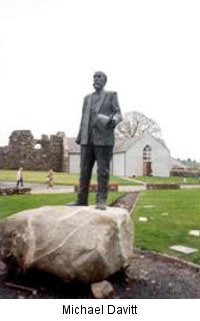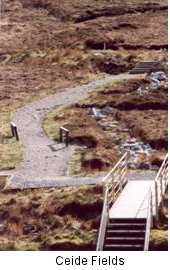Journal Volume 4 2004
County Mayo Tour April 2003 (continued/1)
The morning of our third day we were introduced to Noel O’Neill and his friend Gerry, enthusiastic local historians with a  wealth of information. They called themselves “The last of the summer wine”. I can't make any connection between wine and archaeology but I'm sure they had a good story behind the name as they certainly had a good story for everything else. We stopped in Castlebar and were given a short, informed history of the town. After that we proceeded to the village of Straide, Foxford, where we were given a most interesting talk on the life of Michael Davitt.
wealth of information. They called themselves “The last of the summer wine”. I can't make any connection between wine and archaeology but I'm sure they had a good story behind the name as they certainly had a good story for everything else. We stopped in Castlebar and were given a short, informed history of the town. After that we proceeded to the village of Straide, Foxford, where we were given a most interesting talk on the life of Michael Davitt.
Our next stop was the Céide fields. From the bus we had a splendid view of the cliffs of Céide, an excellent visual example of 300,000,000 years of the Earth’s geological past with hundreds of distinct horizontal layers of shale, sandstone and limestone. The Céide Fields were lived in and worked on over five thousand years ago. Today, beneath four metres of bog is a second landscape, possibly the oldest enclosed landscape in Europe, hidden and untouched for fifty centuries. Inside the interpretive centre we saw that cutting through the bog literally allows one to step back in time and look at the remains of plants from Viking times, Christian times, Roman times, all the way back to the time of the pyramids, a vertical timeline.
 The following morning we left the Atlantic Coast and had a quick stop in Westport for a little sightseeing and shopping. On the advice of Noel our guide, we took a short detour to the Museum of Country Life, Turlough Park. It is the only branch of the National museum of Ireland situated outside Dublin and concentrates on rural life in Ireland from the mid- nineteenth to the mid- twentieth centuries. The collection is a celebration of everyday life and shows the struggle and the skill needed for survival in rural communities. Turlough Park House, the work of Thomas Newenham Deane, the new modern building that nestles into the ground, and the elegant glasshouse were admired by many. Most of the group felt that a second visit to the museum would be worthwhile.
The following morning we left the Atlantic Coast and had a quick stop in Westport for a little sightseeing and shopping. On the advice of Noel our guide, we took a short detour to the Museum of Country Life, Turlough Park. It is the only branch of the National museum of Ireland situated outside Dublin and concentrates on rural life in Ireland from the mid- nineteenth to the mid- twentieth centuries. The collection is a celebration of everyday life and shows the struggle and the skill needed for survival in rural communities. Turlough Park House, the work of Thomas Newenham Deane, the new modern building that nestles into the ground, and the elegant glasshouse were admired by many. Most of the group felt that a second visit to the museum would be worthwhile.
Our last and final visit was to CruachanAi, a modern visitors’ centre in Tulsk where archaeology, history and mythology are brought together in one of the most important royal Celtic royal sites in Europe. Gerry Bracken had provided the centre with some wonderful aerial photography, which was on display. We watched a short video and were given a talk on the recent work of archaeologists and geologists who have been using the latest modern technology to discover more about this fascinating landscape.
After a quick lunch at the centre it was time to head back home. We arrived back in Greystones shortly after six. Many positive comments were made about the trip, which we felt was a great success. The wonderful weather made the trip all the more pleasant. The staff of The Atlantic Coast Hotel should be commended for their excellent service. Many thanks are due to our driver who catered for our every need and comfort throughout our trip.
Credit is also due to Leo Ireton who provided some interesting reading material based on some of our visits. We look forward to next year’s trip with great anticipation.


